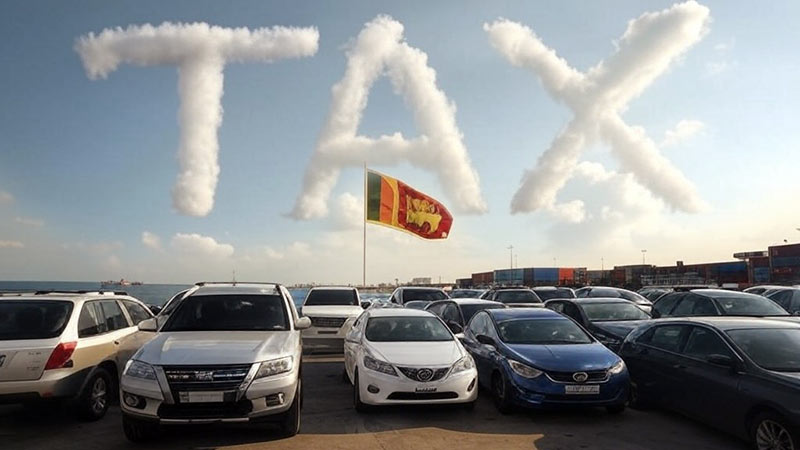Skyrocketing prices make cars unaffordable in Sri Lanka despite lifting vehicle import ban

The Chairman of the Vehicle Importers’ Association of Sri Lanka (VIASL), Indika Sampath Merenchige, has stated that the primary reason for the increase in Japanese vehicle prices is the government’s decision to allow the importation of vehicles that are only up to 2 years old instead of 5 or 7 years old.
This move is expected to have a significant impact on vehicle affordability in Sri Lanka.
He made this statement while commenting on the government’s decision to lift import restrictions and resume vehicle imports starting today (February 1, 2025).
Merenchige warned that due to this decision, an average citizen in Sri Lanka would no longer be able to purchase a vehicle for less than 10 million rupees.
“Ultimately, what will happen is that ordinary people in the country will not be able to buy a vehicle for less than 10 million rupees. If they had allowed 5-year-old vehicles, a car that could have been bought for around 6 to 6.5 million rupees is now unavailable,” he explained.
Merenchige also highlighted that the current auction prices of 2-year-old Japanese vehicles, combined with local tax values, will contribute to the price increase.
Based on the latest pricing trends, the expected costs of popular models in Sri Lanka are as follows:
- Toyota Raize 1200cc: Could reach around Rs. 16 million.
- Toyota Yaris: Could cost more than Rs. 11 million.
- Honda Vezel 1500cc hybrid: Currently priced around Rs. 19.5 million, expected to rise to Rs. 24 million.
- Suzuki Wagon R: A popular model among Sri Lankans, could exceed Rs. 10 million.
More Details on Vehicle Import Policy
The Sri Lankan government has officially lifted the temporary suspension on vehicle imports, which had been in effect since early 2020, through Gazette Extraordinary Notification No. 2421/44, dated January 31, 2025. The new regulations, effective from February 1, 2025, permit the importation of various types of vehicles, including:
- Cars and vans for personal use
- Buses for public passenger transport
- Goods transport vehicles
- Special purpose vehicles
- Trishaws, bicycles, and other non-motorized vehicles
Key Conditions for Vehicle Importation
The government has imposed the following conditions on vehicle importation to ensure economic stability, protect foreign exchange reserves, and regulate the number of imported vehicles:
- Registered Importers: Only importers registered with the Department of Motor Traffic and State Institutions are allowed to import the required number of vehicles under the new regulations.
- Limited Personal Imports: Any individual or entity (other than registered importers) is allowed to import only one vehicle within a 12-month period.
- Mandatory Registration: Any imported vehicle must be registered with the Department of Motor Traffic within 90 days from the date of the Bill of Entry/Customs Declaration (CUSDEC).
- Affidavit Requirement: Importers and buyers must submit an affidavit, including their Taxpayer Identification Number (TIN), to the Department of Motor Traffic for vehicle registration. Personal importers must confirm that they have not imported another vehicle within the past 12 months.
- Late Registration Penalties: If a vehicle is not registered within 90 days, the importer must pay a monthly late fee of 3% of the Cost-Insurance-Freight (CIF) value, up to a maximum of 45% of the CIF value.
- No Exemptions: No waivers will be granted for late registration fees under any circumstances.
- Vehicle Age Calculation: The age of an imported vehicle will be determined based on the period between the Date of Manufacture and the Bill of Lading or Airway Bill date.
- No Import Permit Concessions: Motor vehicles cannot be imported under previously issued concessionary import permits.
- Re-export Requirements: Vehicles imported in violation of regulations must be re-exported within 90 days from the date of the Bill of Entry/CUSDEC.
Customs Import Duty and Surcharge
In addition to the import regulations, the Sri Lankan government has also revised the Customs Import Duty (CID) structure for motor vehicles:
- Gazette Extraordinary Notification No. 2421/05 (January 27, 2025) was issued under the Revenue Protection Act, No. 19 of 1962, re-imposing the CID at 20% of the CIF value.
- Gazette Extraordinary Notification No. 2421/43 (January 31, 2025) introduced a 30% surcharge on the Customs Import Duty, effective from February 1, 2025.
This revised import duty is expected to significantly impact vehicle pricing, making car ownership increasingly difficult for middle-class citizens in Sri Lanka.
Industry stakeholders continue to urge the government to reconsider the 2-year vehicle import age limit, as allowing 5-year-old vehicles could make car ownership more affordable.
Conclusion
The resumption of vehicle imports in Sri Lanka comes with stringent regulations and higher import taxes, making it difficult for the average citizen to afford a vehicle.
Industry experts predict that unless policies are revised, the high costs will limit car ownership to only a small segment of the population, impacting mobility and economic activities in the country.

Latest Headlines in Sri Lanka
- Court of Appeal to rule on IGP Tennakoon’s arrest warrant on March 17, 2025 March 12, 2025
- Military deserter arrested for sexually assaulting doctor at Anuradhapura Hospital March 12, 2025
- Tuition teacher under investigation for student assault ignores NCPA summons March 12, 2025
- Sri Lanka maintains stance on Adani, open to investment March 12, 2025
- Doctors strike over delay in arrest of sexual assault suspect March 12, 2025


